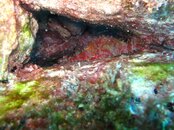This guy is about 5" long (wide?), and is at the North Point site of San Pedro Island in San Carlos, Sonora, Mexico. The area is mostly rocky. I couldn't see it well in the dark, but the picture didn't help one bit! 
This is not a 'normal' starfish, if indeed that is what it is. The 'normal' ones are green with black spikes, and occasionally gray with black and orange spikes.
This is not a 'normal' starfish, if indeed that is what it is. The 'normal' ones are green with black spikes, and occasionally gray with black and orange spikes.




